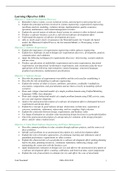Resumen
Complete Summary of all DBA Lectures, Notes and Learning Objectives
- Grado
- Institución
A comprehensive summary of the lectures and lecture notes that were covered in the course Designing Business Applications (DBA) at RSM. The summary includes screenshots/pictures of all key concepts (i.e. learning objectives) of the DBA course. Topics discussed in the lectures include Software Engin...
[Mostrar más]



